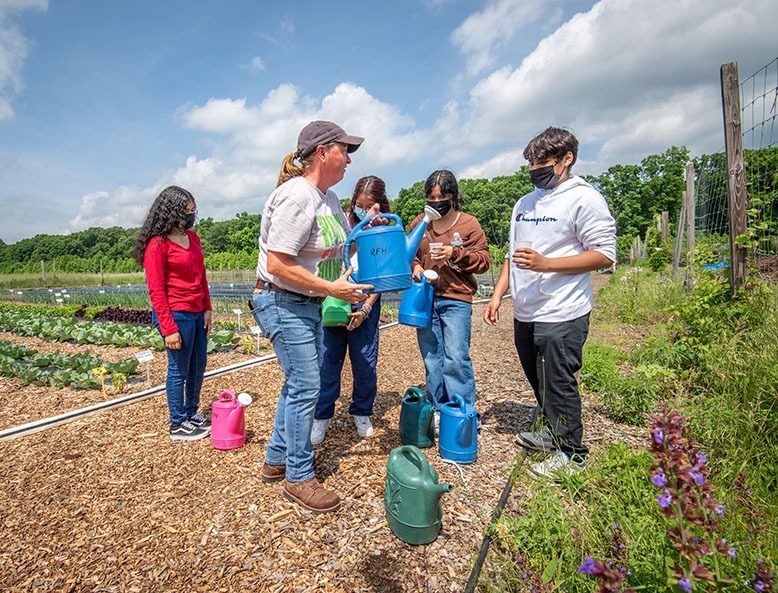
They came, they saw, they composted. The eighth-graders from New Brunswick Middle School stirred compost bins, plucked beetles off potato plants and sowed butternut squash seeds in their visit to Rows for the Hungry, a garden in Davidson’s Mill Pond Park in North Brunswick.
Miriam O’Hare, project manager for Rows for the Hungry, welcomed the young visitors to a butterfly house near the garden. “Does anybody here know anything about pollinators?” she asked.
“No,” the teens said in unison.
“Oh, you’re going to learn,” O’Hare promised.
Through a presentation by volunteer Dale Duchai and a peek inside the butterfly house, the kids learned that bees, butterflies and bats are among the pollinators that help a garden thrive.
Meanwhile, in the rows of the three-quarter-acre garden, 14-year-old Noel Urena wasn’t keen on getting close to the Colorado potato beetles crawling on the potato plants. “Eww!” he grimaced, eyeing the soft, red larvae. But as his classmates busied themselves removing the pests, he, too, began disposing of the larvae in a cup of soapy water.
“I used to do gardening, because my family had a farm in the Dominican Republic,” Urena said. “But not anymore, because we moved.”
Urena and the nearly 100 other students on the field trip are city kids. But many of the immigrants among them spoke of childhood memories. Maria Figueroa, 14, picked a garlic scape and a sprig of oregano to take home. “We had all this at my grandparents’ farm in Mexico,” she said. “We grew avocados, too.”
Dig deep enough into any American’s past, O’Hare said, and you’ll likely find a connection to the land. “We used to be this agrarian society before we became a computer society or whatever we are now,” she explained. “It’s in all of us, this knowledge.”
The primary mission of Rows for the Hungry, a volunteer initiative run by certified Master Gardeners through the Rutgers Cooperative Extension of Middlesex County, is to provide fresh, first-quality produce to people who need it. Everything grown is donated to Elijah’s Promise, which runs a community kitchen, culinary school and other programs in New Brunswick, and to MCFOODS (now Replenish), which collects and distributes food to more than 80 food pantries and service organizations in Middlesex County.
The veggies, all grown organically, include tomatoes, eggplants, peppers, watermelons, leeks, potatoes, sweet potatoes, onions, garlic, squash, broccoli, spinach, kale and herbs. In 2019, the garden’s first year under its current format, Rows for the Hungry donated 4.6 tons of produce. By 2021, Rows had increased its yield to 12.7 tons, mainly through increased efficiency.
“We learned how and what we needed to grow,” O’Hare said. “At first, we grew a lot of heirlooms, but we later looked for disease resistance and shifted into production mode. We put down fabric to eliminate weeding and to make it a sustainable, workable place.”
A secondary mission is to spread knowledge of gardening and food production, and to build community. “We had a huge opportunity to do that with the New Brunswick middle schoolers,” O’Hare said.
Eunice Brown, an eighth-grade English teacher at New Brunswick Middle School, sought out Rows after assigning her class to read the young-adult novel Seedfolks by Paul Fleischman. In the book, neighbors from diverse backgrounds join forces to create an urban garden, strengthening their community.
“I wanted the students to have a real-life connection to our reading,” Brown said. “I was blown away by how Miriam and the tons of volunteers made certain we had that connection. In class, we talked about food deserts, and they walked away from our visit knowing they can grow their own food.”
Brown and O’Hare hope to collaborate again, perhaps with projects at the middle school or a return to the garden at harvest time. “Seeing the excitement on their faces was a thrill for me,” Brown said. “They were saying, ‘I don’t want to leave!’ They had so much fun.”
Before the students boarded a bus for their ride back to school, O’Hare told them they were now members of the Rows for the Hungry family. “We grow food for people who can’t grow it for themselves and who can’t afford or access fresh produce,” O’Hare said. “Now that you know how we do it, we encourage you to come back and keep learning.”
